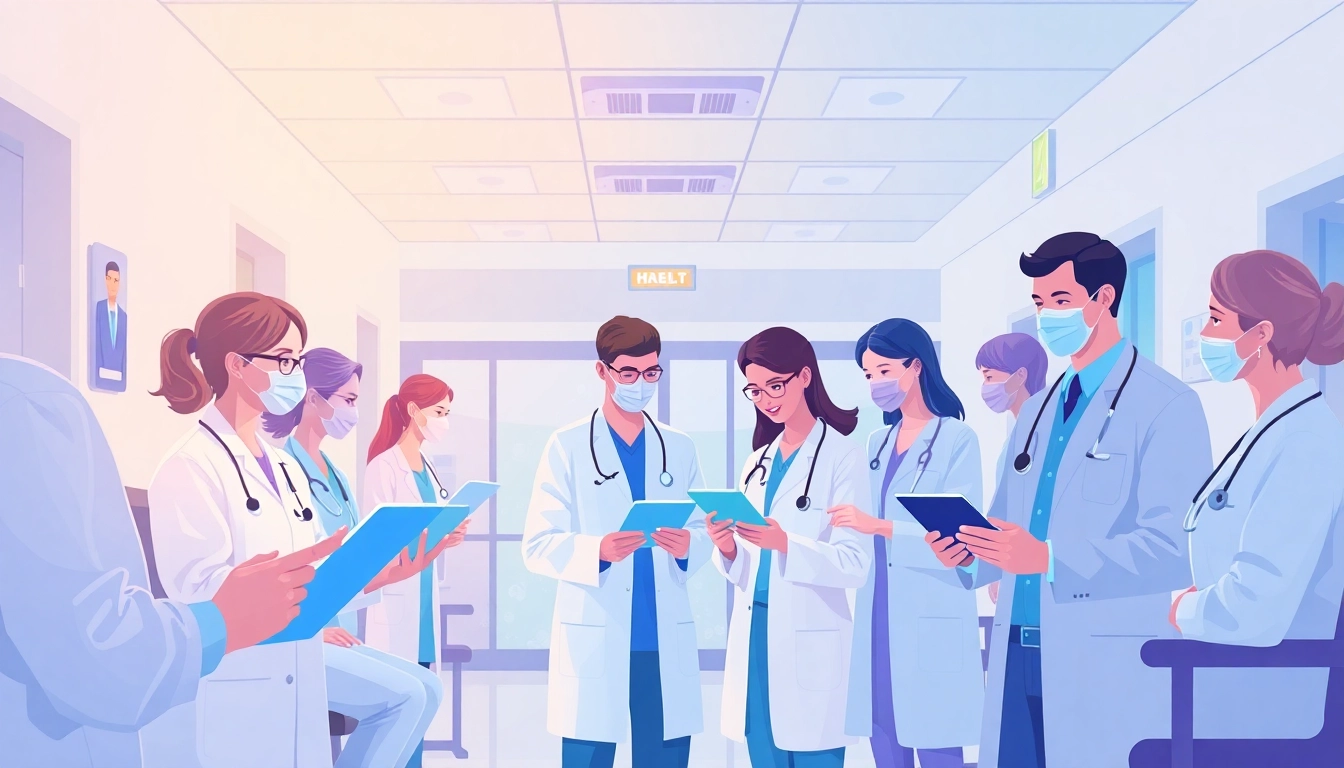Understanding Health Informatics
In an era where data is considered the currency of success across industries, the realm of healthcare is no exception. Health informatics represents a pivotal intersection of information technology, data analysis, and healthcare management, aiming to harness the vast amounts of clinical data generated daily for improved decision-making and enhancing patient outcomes. As noted in various academic discussions, including resources from https://www.informaticsview.com, the relevance of this field extends from academic research to practical applications in healthcare.
What is Health Informatics?
Health informatics is a multidisciplinary domain that involves the optimal use of information and communication technology to manage healthcare-related processes and data. It combines knowledge from computer science, information science, and healthcare in a way that not only streamlines operations but also enhances patient care. The key components of health informatics include the collection, storage, analysis, and dissemination of health-related information to improve health outcomes for individuals and populations.
The Evolution of Healthcare Technologies
The technological landscape of healthcare has undergone dramatic changes over the last few decades. From the early adoption of rudimentary electronic health records (EHRs) in the 1960s to sophisticated telemedicine platforms today, each advancement has contributed to a broader transformative journey aimed at improved patient care. The proliferation of technology in healthcare can be seen as driven by various factors, including the need for efficiency, the capability for real-time data use, and the demand for integrated care.
As healthcare technologies have evolved, so too have methodologies for integrating them effectively within healthcare systems. Initially, the focus was merely on digitization; however, modern health informatics seeks to leverage big data analytics, artificial intelligence, and machine learning to derive actionable insights that can provide predictive and prescriptive analytics in clinical settings.
Importance of Data in Health Informatics
Data serves as the backbone of health informatics. The effective use of data helps healthcare professionals make informed decisions, improve patient safety, and reduce costs. Structured health data, when processed correctly, can reveal patterns that directly impact health outcomes. The integration of data from various sources—including EHRs, clinical decision support systems (CDSS), and patient-reported outcomes—enables a holistic view of patient health, facilitating personalized healthcare strategies and interventions.
Key Applications of Informatics
Electronic Health Records (EHRs)
Electronic Health Records (EHRs) are one of the most significant advancements in health informatics. They enable the digital collection of patient health data, enhancing accessibility and continuity of care. EHRs consolidate patient information from various sources, allowing healthcare providers to view comprehensive patient histories conveniently. This capability is crucial for diagnosing conditions and prescribing treatments effectively.
The utilization of EHRs has been shown to reduce administrative errors, minimize duplicate testing, and enhance collaboration among healthcare teams. Moreover, with functionalities that support clinical reminders and alerts, EHR systems significantly contribute to improved patient safety and quality of care.
Clinical Decision Support Systems (CDSS)
Clinical Decision Support Systems (CDSS) leverage patient data to provide healthcare professionals with recommendation tools designed to enhance clinical decision-making. These systems analyze data from EHRs and other sources to deliver evidence-based clinical guidelines and alerts concerning potential drug interactions, allergies, or recommended preventive measures.
The integration of CDSS in healthcare settings can foster adherence to best practices, reduce variability in care, and promote the overall clinical workflow’s efficiency. Studies indicate that CDSS use can lead to improved healthcare outcomes, such as reduced rates of medication errors and unnecessary testing.
Telemedicine and Remote Patient Care
Telemedicine, as a branch of health informatics, has revolutionized the way healthcare is delivered, particularly during times of crisis like the COVID-19 pandemic. It allows patients to consult with healthcare providers remotely, utilizing video conferencing and interactive platforms. This approach not only increases access to care for patients in remote areas but also enhances the efficiency of healthcare delivery.
Remote patient monitoring, another aspect of telemedicine, enables continuous health data tracking through wearable devices. This capability empowers patients to manage their health proactively and allows healthcare providers to intervene without the need for in-office appointments.
Challenges in Implementing Informatics Solutions
Interoperability Issues
Despite the numerous advantages of health informatics, interoperability remains one of the significant challenges faced by health systems. Different EHRs and health record systems often operate in silos, preventing seamless information exchange between providers. This fragmentation can impede quality care and lead to duplicated testing or errors.
To address interoperability challenges, it is essential for stakeholders to adopt standardized data formats and protocols, such as HL7 and FHIR, which can facilitate better communication across diverse systems. Developing a robust integration strategy that includes stakeholder cooperation will be paramount in enhancing data sharing capabilities.
Training and Adoption Barriers
Another critical challenge in deploying health informatics solutions lies in inadequate training and resistance to change among healthcare providers. Staff often find it difficult to adapt to new systems or workflows, which can hinder the successful adoption of informatics solutions.
To overcome these barriers, healthcare institutions must prioritize continuous education, offer comprehensive training programs, and create a culture that embraces technology as a crucial tool for improving patient care. Fostering an environment that emphasizes user engagement and feedback can ease the transition to new systems and processes.
Data Security and Privacy Concerns
With the extensive use of electronic systems to manage sensitive patient information, data security and privacy have become paramount concerns in health informatics. Cybersecurity threats pose significant risks, particularly as the volume of health data continues to grow, raising the stakes for patient confidentiality.
Implementing robust security protocols, including encryption and multi-factor authentication, is essential. Healthcare organizations must also adhere strictly to regulations such as the Health Insurance Portability and Accountability Act (HIPAA), which governs the confidentiality and security of healthcare information. Regular audits and assessments can help ensure compliance and identify potential vulnerabilities in the system.
Best Practices for Effective Informatics
Integrating User-Centered Design
User-centered design (UCD) is a best practice that focuses on creating informatics solutions tailored to the needs and preferences of end-users. Involving healthcare professionals in the design process ensures that systems are intuitive, efficient, and truly address the challenges they face in their daily workflows.
Engaging end-users through surveys, focus groups, and iterative testing allows developers to gather valuable feedback, which ultimately results in systems that are more likely to be adopted and utilized effectively. Moreover, ensuring that the interface is user-friendly can enhance satisfaction and usability among healthcare providers.
Ensuring Compliance with Regulations
Compliance is a critical aspect of successfully implementing health informatics solutions. Healthcare organizations must continuously monitor and update their systems to comply with state, federal, and international regulations regarding data use, privacy, and security.
Establishing a compliance framework that includes regular training programs for staff and ongoing audits can help organizations stay ahead of the regulatory curve. This proactive approach not only protects patient data but also builds trust in healthcare systems.
Continuous Education and Training
In a rapidly evolving field like health informatics, continuous education and training are essential to keep healthcare professionals abreast of the latest technologies, methodologies, and regulatory changes. Organizations should offer regular training programs that address emerging tools in informatics, as well as updates on regulatory compliance and best practices.
Encouraging staff to participate in professional development opportunities and industry conferences further enhances their knowledge base and ability to provide high-quality patient care. By fostering a learning culture, healthcare institutions can effectively adapt to the ongoing changes in health informatics.
The Future of Health Informatics
Innovations on the Horizon
The future of health informatics promises an array of innovations that will continue to shape the healthcare landscape. Emerging technologies like blockchain, which offers secure, decentralized data management, and advanced analytics tools that harness big data’s insights will be at the forefront of this evolution.
These advancements are likely to drive improved patient outcomes by facilitating smarter decision-making processes and enhancing operational efficiencies. Innovations in mobile health applications will empower patients even further, allowing them to take control of their health data.
Impact of Artificial Intelligence
Artificial Intelligence (AI) is set to transform health informatics by automating routine tasks, identifying patterns in vast datasets, and providing predictive insights. AI can analyze patient data and assist clinicians in detecting diseases at earlier stages than human capability alone might allow.
Moreover, AI-driven algorithms can optimize treatment plans tailored to individual patient profiles, thereby personalizing care and improving overall outcomes. As AI technology continues to evolve, its integration into health informatics will become increasingly seamless, driving efficiencies at all levels of care delivery.
Trends in Patient Engagement Technologies
Patient engagement is becoming a focal point within health informatics, as engaged patients tend to have better health outcomes. Technologies such as mobile apps, secure messaging platforms, and interactive patient portals enhance communication between healthcare providers and patients, encouraging active participation in their healthcare journey.
Future trends will likely see even greater emphasis on user engagement strategies that leverage data insights to foster meaningful interactions. Patient education through digital channels, personalized reminders, and tailored content will play a significant role in enhancing patient experience and adherence to treatment plans.















Leave a Reply